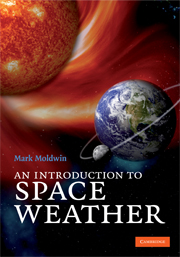Book contents
- Frontmatter
- Contents
- Preface
- Acknowledgments
- 1 What is space weather?
- 2 The variable Sun
- 3 The heliosphere
- 4 Earth's space environment
- 5 Earth's upper atmosphere
- 6 The technological impacts of space storms
- 7 The perils of living in space
- 8 Other space weather phenomena
- Appendix A Web resources
- Appendix B SI units
- Appendix C SI prefixes
- References
- Historical bibliography
- Index
- Plate section
7 - The perils of living in space
Published online by Cambridge University Press: 05 June 2012
- Frontmatter
- Contents
- Preface
- Acknowledgments
- 1 What is space weather?
- 2 The variable Sun
- 3 The heliosphere
- 4 Earth's space environment
- 5 Earth's upper atmosphere
- 6 The technological impacts of space storms
- 7 The perils of living in space
- 8 Other space weather phenomena
- Appendix A Web resources
- Appendix B SI units
- Appendix C SI prefixes
- References
- Historical bibliography
- Index
- Plate section
Summary
“My God, Space is radioactive!” Ernie Ray's exclamation after seeing the data returned from Explorer 1, the first US satellite launched in 1958. The radiation was space radiation in the Van Allen radiation belts.
Quoted in Hess (1968).Key concepts
protected by the atmosphere and magnetosphere
types of radiation – electromagnetic and corpuscular
rems (radiation equivalents in man)
Introduction
Life on Earth has an over 3.5 billion year history. It had a beginning and it will have an end. The longest that life can possibly exist on Earth into the future is approximately 4 billion years, though a number of catastrophes can happen on much shorter timescales (some of these are discussed in Chapter 8). In approximately 4 billion years, our Sun will run out of nuclear fuel and enter what is called the Red Giant phase of stellar evolution. It will expand perhaps past the orbit of Earth, vaporizing Mercury, Venus, and Earth. If humans are to survive the end of Earth, we will have to develop the technological capability to move to another star system. Humans have made the first tentative steps off Earth. We routinely fly astronauts into low-Earth orbit, and the US and China plan to have a manned presence on the Moon and Mars in the relatively near future. However, the technological obstacles to space travel are daunting – some say even insurmountable.
- Type
- Chapter
- Information
- An Introduction to Space Weather , pp. 95 - 111Publisher: Cambridge University PressPrint publication year: 2008

